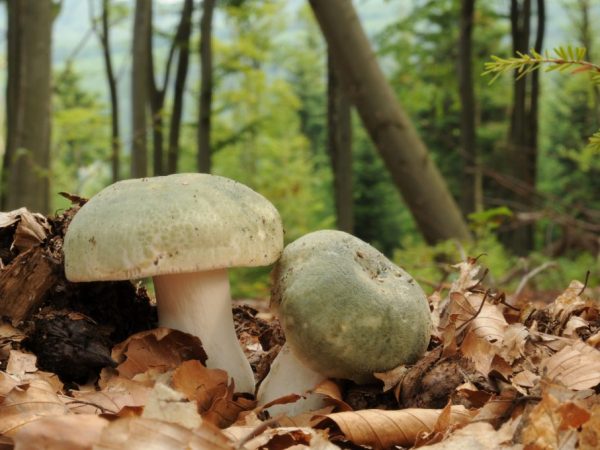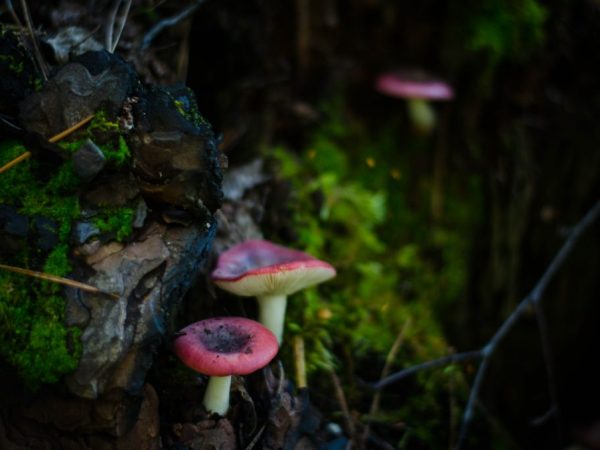Varieties of false russula
The false russula is a poisonous and dangerous twin, with which mushroom pickers often confuse representatives of the edible species. It has several varieties, both conditionally edible and poisonous.

Varieties of false russula
Russula caustic
Caustic russula belongs to the inedible representatives of the genus russula. Its cap has a red or purple color, its diameter ranges from 5 to 10 cm. At the edges, the color shade is noticeably lighter. The shape of the mushroom cap directly depends on age: initially (in young mushrooms) it has a hemispherical shape, then it becomes convex or outstretched and depressed. The surface is sticky, the skin can be easily removed.
The caustic russula has other names: p. emetic and c. stingingly caustic.
A mushroom leg 4-7 cm long, fragile in structure, hollow inside, in the form of a cylinder. Its color is often white, the presence of a pink tint is permissible near the base.
The mushroom plates are wide, planted with medium frequency, and are white. Mushroom pulp is closer to white, thin-fleshy. The structure of the pulp of young mushrooms is dense, but over time it gradually becomes loose. The pulp has a pronounced mushroom smell and a pungent-bitter taste.
Inedible russula pungent begin to grow from the second half of summer until mid-autumn. Distributed throughout the European territory of Russia.
The main growth areas are moist forests of coniferous and mixed types.
Irina Selyutina (Biologist):
The russula is considered inedible according to some data, and a conditionally edible species according to others. It's all about her bitter taste. Foreign sources are of the opinion about its weak toxicity, which can cause disturbances in the work of the human gastrointestinal tract. There is also information about the presence of muscarine in its pulp, which in itself is already dangerous. However, some mushroom pickers believe that after 20 minutes of boiling with the obligatory draining of the liquid and then thorough rinsing under running water, these mushrooms can make them suitable for human consumption. A homeopathic preparation "Agaricus emeticus" has been created on the basis of the stinging russula, which is used as part of combination therapy for:
- states of intoxication;
- typhoid fever;
- gastritis;
- enterocolitis.
The caustic russula enters into a symbiotic relationship, forming mycorrhiza with representatives of coniferous and deciduous tree species.
Russula blood red
The blood-red russula species got its name due to the bright "bloody" color of the cap. It is included in the category of inedible mushrooms. The hat is bright red, it can be crimson, scarlet, carmine. In the heat, the color loses its color contrast, becoming light pink, which is very dangerous for novice mushroom pickers. The surface is shiny, with a light sticky layer. When dry, it becomes dull. The shape of the mushroom cap is initially in the form of a hemisphere, then it takes on a spread-flat or depressed appearance. Hat edges are wavy or ribbed.
The blood-red russula is also called c. sardonyx.
The leg of this russula is in the form of a cylinder or club-shaped, reaches 3-8 cm in length, in a contrasting pink tone. The mushroom plates are narrow, often planted, painted in shades of white or light brown, closer to cream, sometimes covered with yellowish specks. The structure of the white mushroom pulp is dense, there is no smell, the taste is spicy.
The blood-red russula species has similar edible varieties:
- Russula pink, or beautiful: the cap is usually carmine red, brighter in the center, but in wet weather the pigments can be washed out from the integumentary skin and it acquires a lemon-yellow color. The peel does not come off well.
- Swamp russula, or float: grows only among mosses and has a mushroom leg an order of magnitude lighter than the cap, the color of which (in the center is dark red, along the edge is bright pink or red) fades over time and becomes orange or red-orange.
- Brown russula: its cap is painted in dark colors (at the edge it is violet-red, in the center it is usually violet-black, sometimes with brownish spots) and has a characteristic fishy or shrimp odor.
This species of russula grows mainly on sandstones and acidified soil in pine and mixed forests, rarely in open areas. Active growth occurs in late summer and mid-autumn. The mushroom is not used for food purposes. Not used in medicine.
Spicy russula

Black False Mushroom Center
Eating russules are among the inedible mushrooms. Mushroom caps of this species grow up to 4-10 cm in diameter, the color range varies from lilac and purple to light purple, while the central part often has a shade close to black. The appearance of the mushroom cap at a young age is convex, in adult mushrooms it is depressed, the edges are aligned or mottled.
The mushroom leg is smooth, with a solid structure, painted in pink or purple tones. Hymenophore plates are often planted, narrowish, yellowish in color. The mushroom pulp also has a yellowish color and a pungent-bitter aftertaste.
The period of growth of inedible acute-eating false russula is the last days of August-early October.
The geography of growth covers the temperate latitudes of Eurasia. Preferred areas are sandy soils in pine and spruce forests.
In cooking and medicine, spicy mushrooms are not used.
Birch russula
This species - birch russula, is among the inedible representatives of the genus, capable of causing mild gastrointestinal poisoning. The mushroom cap is beige, yellow, sometimes purple. It grows with a diameter of 3-7 cm, so that we can say - this is one of the smallest representatives of the genus. Initially, its shape is convex or in the form of a hemisphere; in adult mushrooms it transforms into a flat-out or slightly depressed one. The surface is slippery and dull when dry. The peel from the surface of the cap is easily removed.
The mushroom leg is white, 3-9 cm high, fragile in structure, initially (in young specimens) solid, later - hollow. Mushroom plates are white, often planted, sometimes torn.
The birch russula has twin mushrooms:
- The russula is the most elegant: differs in less contrasting color and a smaller diameter of the cap, which reaches 2-6 cm in diameter. It is characterized by a hemispherical shape at the beginning of its development, which is then transformed into a flat one. The hat is thin fleshy. The skin is sticky at first, then dry, matte. The color is purple, pale purple, pink, in the central part it can sometimes be mixed with greenish-gray or olive tones. The skin "voluntarily" is removed only from 1/3 to 1/2 of the radius of the cap. The taste is spicy. It is considered to be edible after boiling. In European countries, it is considered inedible.
- Brittle russula: the peel from the surface of the cap is removed relatively well. The color of the cap is varied: in reddish, purple, olive green, or generally white or lemon yellow. The pulp is characterized by a pungent taste, brittleness (hence the name), sweetish odor, white or yellowish color. Refers to inedible mushrooms. May cause minor gastrointestinal upset when eaten raw.
Birch russula grows in wet wetlands in woodlands, not far from birches. The time of active growth is mid-June-early October. The mushroom is included in the Red Data Books of several countries of the world. It is not used for food purposes due to the pungent-bitter aftertaste. Not applicable in medicine.
Conclusion
False russula are different species that, in terms of their external description, are similar to good edible mushrooms. Among the edible and inedible varieties there are russula, unsuitable for food due to the characteristic pungent-bitter taste or prohibited for use due to the poisonous substances contained in the composition.



